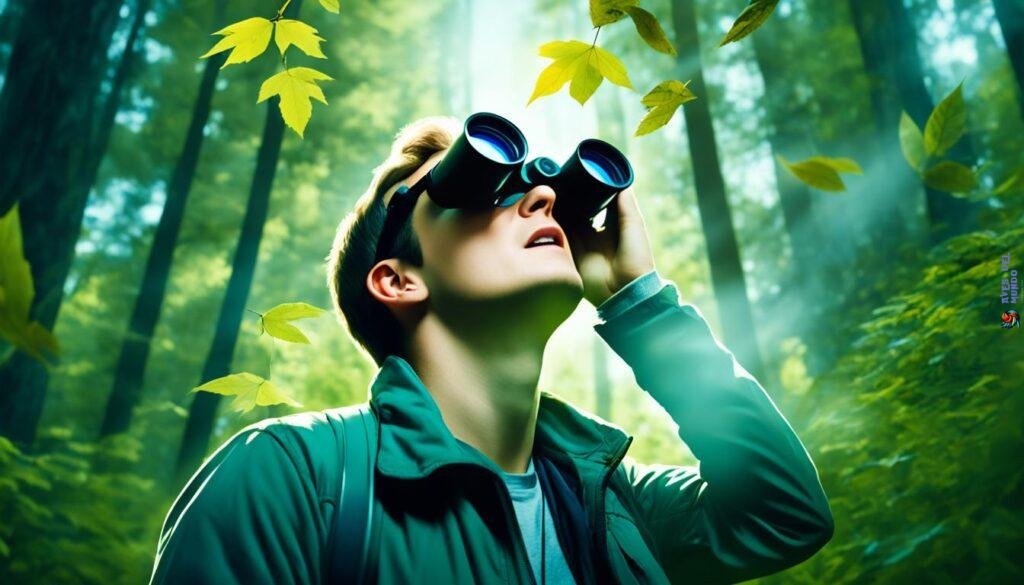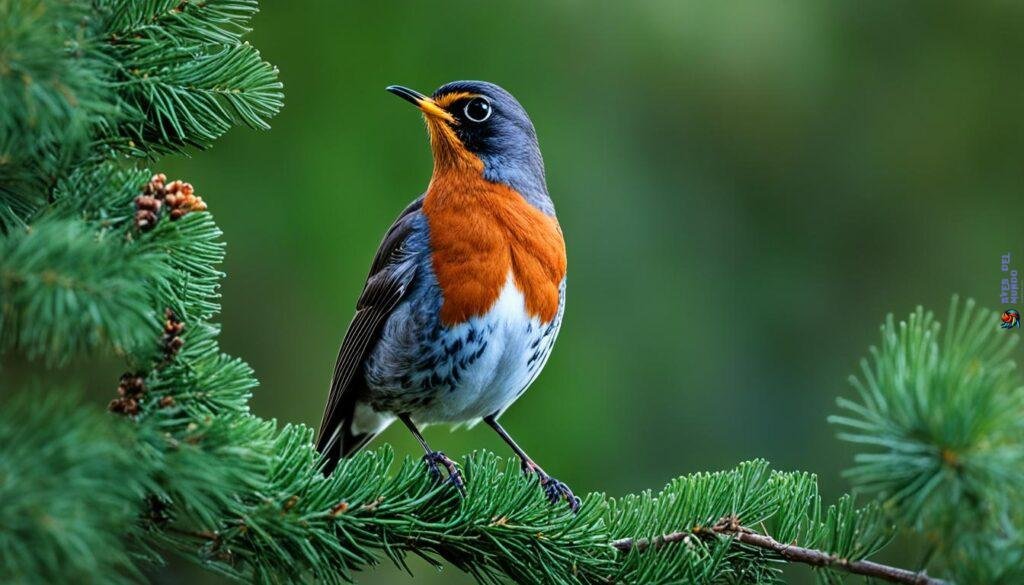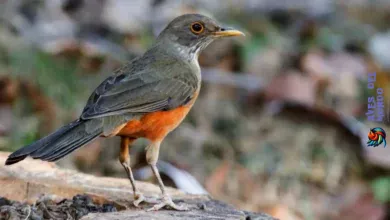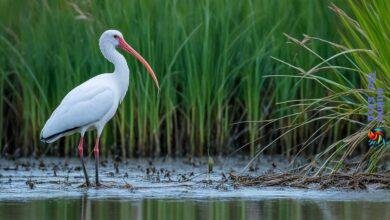Did you know some bird watchers recognize over 200 bird species by their song? Mastering how to identify birds by their song is a transformative experience. It lets you enjoy the wild chorus of spring fully. Kenn Kaufman, a field editor at Audubon, says knowing bird song identification is key. This is especially true when you can’t see the birds in a thicket.
If you’re new to birding or already love it, the art of bird audio identification is waiting for you. Listen closely to the sky’s symphonies, as each sound becomes part of your own memory. Embrace the warm months with an immersive listening adventure. Now, every bird call adds to your avian knowledge.
Resources from groups like Audubon and their free apps make learning fun and easy. Discover the joy of recognizing bird sounds, and let your education soar. Join us to learn tips, tools, and stories. These will help you become a great listener of nature’s music.
The Joy and Challenge of Birding By Ear
Starting the journey of birding by ear combines the joy of nature with learning to identify bird species by sound. This not only makes your time outside more fun but also sharpens your listening skills. Understanding bird sounds is key to enjoying birding, whether you’re an expert or just starting.
Understanding the Importance of Bird Vocalizations
Birds make a rich tapestry of sounds that tell us about their lives. Each sound gives clues about the bird’s type, where it is, and what it’s doing. Knowing how to recognize these sounds can turn a quick look into a meaningful observation.
Some birds live hidden in places like marshes, making it hard to see them. But their unique calls let us know they’re there. This is how sound becomes a vital part of birding. It’s like adding sound to a silent movie, making everything come alive.

Embracing the Bird Songs as a Gateway to Identification
To get better at this, you must learn the different bird songs. The melody of a songbird, the tapping of a woodpecker, or the call of a warbler hidden in bushes. These sounds help identify birds even when we can’t see them.
With birding by ear, you connect deeply with birds’ lives. As you learn more calls, you enjoy and understand more about birds with each visit outdoors.
How to Identify Birds by Their Song
Starting your journey in learning bird songs makes outings in nature richer. It connects us to a deep part of human culture. William Shakespeare showed us in «Romeo and Juliet» how special it is to know birds by their songs. This skill brings joy to birders as they identify birds by their melodies. They don’t just rely on how birds look.
Bird sound is key for identifying them. Start with birds like the American Robin that you hear often. Move to more rare ones as you get better. This way helps you remember lots of bird songs. It makes identifying birds by ear exciting and useful.
- Get to know the bird sounds in your area.
- Understand different bird sounds, like mating calls and alarm calls.
- Go on bird listening walks to learn from experts in nature.
Recognizing birds by their song connects you deeper with nature. A hidden bird makes itself known through its unique song. Knowing its call means you can tell it’s there, watch its behaviors, and understand its living area’s health.

To get good at learning bird songs, practice a lot. Your backyard or a nearby park are great places to start. Listen for bird songs on morning walks or through your window. This practice helps you pick up on small differences in bird calls.
Be patient as you learn. The subtle changes in sound take time to spot. Here’s a table to help you start with some common birds and their songs:
| Common Name | Typical Song | Habitat Notes |
|---|---|---|
| American Robin | Cheerful series of melodious phrases | Urban and suburban areas, forests, parks |
| Northern Cardinal | Whistled, sweet, long, and clear twitters | Woodlands, gardens, shrublands |
| Black-capped Chickadee | Simple, clear ‘chick-a-dee-dee’ or ‘fee-bee’ | Mixed forests, willow thickets |
| Mourning Dove | Soft, woeful cooing | Open fields, farmlands, residential areas |
As you practice, recognizing birds by their song becomes easier. Spending time on this hobby is rewarding. Soon, you’ll identify birds just by hearing them, even if you can’t see them.
Beginning Steps in Learning Bird Songs
Starting to identify bird songs can make birding more fun. Beginning with birds you often see makes it easier to learn. These tips can help you listen better and enjoy birding by ear.
Starting with Common Species
The American Robin is great for beginners. Their unique songs are familiar in many places across North America. By learning their sounds first, you’ll get better at identifying rarer and more complicated bird calls.
Utilizing Mnemonics for Easier Recall
Mnemonics turn complicated bird calls into easy phrases to remember. For example, thinking of the Barred Owl’s hoot as «Who cooks for you?» makes it easier to remember when you hear it outside. This method is very useful, especially when there are a lot of birds singing.
Keep these tips in mind as you start recognizing bird songs. It will make your birding more rewarding and fun. Let nature’s music help you learn the language of birds.
Advanced Techniques for Bird Call Recognition
As a bird enthusiast, learning to recognize birds by their song is both fun and challenging. It takes dedication and practice. By getting to know their vocalizations, you can identify many bird species using only your ears. This part will show you advanced methods to help you tell apart and document the varied songs birds make.
Analyzing Patterns and Repetitions in Songs
To get better at identifying birds by their song, start by noticing their repetitive patterns. Each bird species has its own unique pattern. Learning these can help you know which bird is singing. Paying close attention to the number of notes and changes in tone can help you understand the rhythm of their songs.
Deciphering Complex Bird Calls
Some bird songs are complex, almost like music. These intricate calls need a keen ear to pick apart different parts. Using drawings or notes to picture bird songs can help a lot. It makes it easier to notice the special details in pitch, speed, and rhythm that each bird song has.

| Bird Species | Song Patterns | Notes Description | Rhythm and Cadence |
|---|---|---|---|
| American Robin | Whistled phrases repeating 2-3 times | High-low sequences with clear, whistled sound | Smooth, evenly spaced, with pauses between phrases |
| Common Yellowthroat | Short, repeated ‘wichity-wichity-wichity’ | Sharp chips, rising in pitch | Urgent tempo, often constant |
| Northern Mockingbird | Long series with many repetitions | Wide-ranging imitations of other birds | Varies, mimics pattern of copied song |
| Wood Thrush | Fluted, ethereal tone, unique phrases | Harmonic sequences with a haunting quality | Gentle, lilting, and often uninterrupted |
With these advanced tips for recognizing bird calls, you’re on your way to becoming a skilled birder. Remember, practice makes perfect. Spend time outdoors and let the beautiful sounds of birds become something you can easily understand and enjoy.
The Role of Technology in Bird Song Identification
The digital age has brought high-tech tools to bird lovers. It has made identifying bird sounds innovative. Birding apps and online databases are key in learning about birds. They help both beginners and expert birdwatchers. These tools make recognizing bird calls easier and more accurate.

Using Birding Apps: From Merlin to Audubon
Birding apps, like Merlin Bird ID, have changed the game. They are easy to use and provide quick, right answers. Your phone can now listen, identify, and teach about birds. This takes birding to a new level.
The Value of Online Bird Sound Databases
Online bird sound databases, like those from the Audubon Society, are valuable. They have a lot of bird sounds for you to study. Using these resources improves your ability to tell birds apart by sound. This is true even for birds with similar calls.
Seasonal Variations in Bird Vocalizations
Exploring bird sounds, it’s key to see that bird calls recognition changes over time. The beautiful sounds of birds change with the seasons. To get good at recognizing birds by sound, see these changes as clues. They help you identify birds just by hearing them.

In spring and early summer, North America and the UK are alive with birds singing. This period is known as the dawn chorus. It’s a prime time for bird calls recognition, as bird songs are at their loudest. Birds sing not just for our pleasure but to communicate. They signal for mates and mark their territories.
Listening to the dawn chorus feels like you’re at a majestic orchestra. Each bird species by sound adds a unique note to the overall melody.
Knowing the pattern of bird sounds helps you guess which birds you’ll hear. Below is a table that shows common North American birds and how their songs change with the seasons:
| Bird Species | Spring | Summer | Fall | Winter |
|---|---|---|---|---|
| American Robin | Peak vocalizations | Continued song | Decreased singing | Minimal |
| Northern Cardinal | Highly active | Reduced melody | Occasional chirps | Intermittent song |
| Song Sparrow | Intense singing periods | Wanes post-breeding | Rare calls | Quiet |
| Blue Jay | Communal calls | Decline in vocalization | Alert calls common | Social interaction sounds |
This table is a guide to the bird songs you’ll hear in each season. Whether the lively spring songs excite you or the calm autumn tunes speak to you, your adventure in bird calls recognition will be rich and diverse. Let the sounds of birds mark the time of year for you. Enjoy learning the many voices in nature’s incredible choir.
Field Strategies for Bird Audio Identification
As a birder, learning to identify species by their calls is crucial. Effective field strategies for bird audio identification can help. They involve mastering recording practices and observing birds in their natural settings to recognize their calls.
Best Practices for Recording and Observing Bird Songs
To record bird songs well, positioning matters. You may need to avoid wind or noise from people. Listen carefully; move if there’s too much background noise. Seeing the bird as it sings helps link the sound to the species.

The Merlin Bird ID app is a top tool for birders. It lets you review your recordings and compare them with a vast library of sounds. This app boosts your bird audio identification abilities significantly.
Interpreting Bird Sounds in Natural Habitats
Identifying birds starts with recording their sounds. Then, you must interpret what you hear. Is it a call, song, or alarm note? Each type of sound offers hints about the bird’s actions and identity. Mastering these differences shows expertise in bird calls recognition.
For effective sound interpretation, remember these tips:
- Look at the sound’s context. Calls vary with activities like breeding or feeding.
- Consider the sound’s pitch, rhythm, and repetition. These help identify species.
- Confirm what you hear with a field guide. Seeing the bird reinforces learning.
Below is a table summarizing features to tell bird calls apart:
| Feature | Call | Song |
|---|---|---|
| Length | Short | Longer and more complex |
| Purpose | Alerts, contact calls | Mate attraction, territorial |
| Repetition | Often repeated | Varies, often more patterned |
| Time of Day | Anytime | Often dawn and dusk |
| Variation | Less variation | More varied with many notes |
Use these insights in your approach for better birding by ear. Remember, patience and practice will make your birding trips more rewarding. And bird audio identification will deepen your connection to nature.
Building Your Personal Bird Song Library
When you start to recognize bird songs, creating your own collection is a rewarding step. This hobby not only entertains but also sharpens your ability to identify bird calls. Recognizing these calls is crucial, and birding apps and online bird sound databases are great tools for this.
Creating a Comparative Analysis of Bird Sounds
Making recordings on your birding trips lets you examine each song closely. By comparing these recordings, using tools like spectrograms from birding apps, you can tell birds apart more easily. This kind of analysis is not only interesting but also useful for learning bird calls.

Sharing and Contributing to Citizen Science Projects
Sharing your bird song recordings helps everyone. It boosts community databases and adds to our knowledge pool. Your recordings support projects like eBird and the Macaulay Library, which rely on birders everywhere. By sharing, you improve online bird sound databases, help create better birding apps, and push forward sound research. Getting involved helps enhance automated bird call ID and grows citizen science efforts.
| Recording Tips for Personal Bird Song Library | Benefits to Community and Science |
|---|---|
| Use a high-quality recording device for clarity | Improved data quality in sound archives |
| Note the date, time, and location for each recording | Provides context for ecological and behavioral studies |
| Regularly update your library with new sounds | Continually enhances machine learning models in birding apps |
| Compare and analyze songs using app-generated spectrograms | Assists in developing richer, more accurate online databases |
Find joy in birding and make a difference. By collecting and sharing bird songs, you help us all understand the world of birds better. Every sound you capture and share moves us closer to knowing how birds communicate across the skies.
Engaging with the Birding Community to Enhance Learning
When you start to learn how to recognize birds by their song, the birding community is crucial. This community is like a huge, live library. It’s filled with tips on how to master birding by ear. By joining conversations on birding apps and online forums, you access tons of knowledge and different methods to learn bird songs. Sharing and learning together make both you and the birding world smarter.
Bird walks and events by the community are key to really getting into birdwatching. Here, you make friends who love birdwatching as much as you do. Their shared excitement and tips can really help you get better at recognizing birds by their song. Plus, it’s a lot of fun to learn with others who are as eager to explore bird calls as you are.
Getting good at birding by ear is something we do together, not alone. Take every chance to work with others, like sharing bird songs you’ve recorded or joining in on science projects. The birding community is full of insights and stories that can help you understand birds better and improve your skills in learning bird songs.



